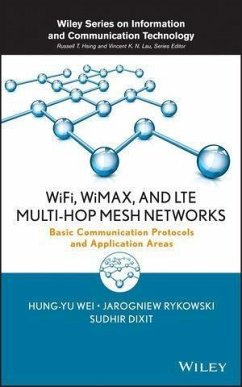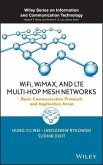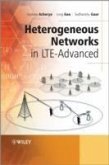WiFi, WiMAX, and LTE Multi-hop Mesh Networks (eBook, ePUB)
Basic Communication Protocols and Application Areas


Alle Infos zum eBook verschenken

WiFi, WiMAX, and LTE Multi-hop Mesh Networks (eBook, ePUB)
Basic Communication Protocols and Application Areas
- Format: ePub
- Merkliste
- Auf die Merkliste
- Bewerten Bewerten
- Teilen
- Produkt teilen
- Produkterinnerung
- Produkterinnerung

Hier können Sie sich einloggen

Bitte loggen Sie sich zunächst in Ihr Kundenkonto ein oder registrieren Sie sich bei bücher.de, um das eBook-Abo tolino select nutzen zu können.
Wifi, WiMAX, and Cellular Multihop Networks presents an overview of WiFi-based and WiMAX-based multihop relay networks. As the first text to cover IEEE 802.16j multihop hop relay technology, this revolutionary resource explores the latest advances in multi-hop and ad-hoc networking. Not only does this reference provide the technological aspects, but also the applications for the emerging technology and architectural issues. Ranging from introductory material to advanced topics, this guidebook is essential for engineers, researchers, and students interested in learning more about WiFi and WiMAX multihop relay networks.…mehr
- Geräte: eReader
- mit Kopierschutz
- eBook Hilfe
- Größe: 5.16MB
![WiFi, WiMAX, and LTE Multi-hop Mesh Networks (eBook, PDF) WiFi, WiMAX, and LTE Multi-hop Mesh Networks (eBook, PDF)]() Hung-Yu WeiWiFi, WiMAX, and LTE Multi-hop Mesh Networks (eBook, PDF)104,99 €
Hung-Yu WeiWiFi, WiMAX, and LTE Multi-hop Mesh Networks (eBook, PDF)104,99 €![Design, Deployment and Performance of 4G-LTE Networks (eBook, ePUB) Design, Deployment and Performance of 4G-LTE Networks (eBook, ePUB)]() Ayman ElnasharDesign, Deployment and Performance of 4G-LTE Networks (eBook, ePUB)89,99 €
Ayman ElnasharDesign, Deployment and Performance of 4G-LTE Networks (eBook, ePUB)89,99 €![Radio Protocols for LTE and LTE-Advanced (eBook, ePUB) Radio Protocols for LTE and LTE-Advanced (eBook, ePUB)]() Seungjune YiRadio Protocols for LTE and LTE-Advanced (eBook, ePUB)111,99 €
Seungjune YiRadio Protocols for LTE and LTE-Advanced (eBook, ePUB)111,99 €![Heterogeneous Networks in LTE-Advanced (eBook, ePUB) Heterogeneous Networks in LTE-Advanced (eBook, ePUB)]() Joydeep AcharyaHeterogeneous Networks in LTE-Advanced (eBook, ePUB)91,99 €
Joydeep AcharyaHeterogeneous Networks in LTE-Advanced (eBook, ePUB)91,99 €![LTE Security (eBook, ePUB) LTE Security (eBook, ePUB)]() Dan ForsbergLTE Security (eBook, ePUB)95,99 €
Dan ForsbergLTE Security (eBook, ePUB)95,99 €![LTE-Advanced and Next Generation Wireless Networks (eBook, ePUB) LTE-Advanced and Next Generation Wireless Networks (eBook, ePUB)]() Guillaume De La RocheLTE-Advanced and Next Generation Wireless Networks (eBook, ePUB)107,99 €
Guillaume De La RocheLTE-Advanced and Next Generation Wireless Networks (eBook, ePUB)107,99 €![Fundamentals of 5G Mobile Networks (eBook, ePUB) Fundamentals of 5G Mobile Networks (eBook, ePUB)]() Jonathan RodriguezFundamentals of 5G Mobile Networks (eBook, ePUB)94,99 €
Jonathan RodriguezFundamentals of 5G Mobile Networks (eBook, ePUB)94,99 €-
-
-
Dieser Download kann aus rechtlichen Gründen nur mit Rechnungsadresse in A, B, BG, CY, CZ, D, DK, EW, E, FIN, F, GR, HR, H, IRL, I, LT, L, LR, M, NL, PL, P, R, S, SLO, SK ausgeliefert werden.
- Produktdetails
- Verlag: John Wiley & Sons
- Seitenzahl: 280
- Erscheinungstermin: 5. März 2013
- Englisch
- ISBN-13: 9781118571118
- Artikelnr.: 37791852
- Verlag: John Wiley & Sons
- Seitenzahl: 280
- Erscheinungstermin: 5. März 2013
- Englisch
- ISBN-13: 9781118571118
- Artikelnr.: 37791852
- Herstellerkennzeichnung Die Herstellerinformationen sind derzeit nicht verfügbar.
Preface xiii
About the Authors xvii
List of Figures xix
List of Tables xxv
1 Introduction 1
2 Architectural Requirements for Multi-hop and Ad-Hoc Networking 9
2.1. When and Where Do We Need Ad-Hoc Networking? 9
2.2. When Do We Need Multi-hop? How Many Hops Are Sufficient/Necessary? 12
2.3. Anonymity versus Authorization and Authentication 13
2.4. Security and Privacy in Ad-Hoc Networks 17
2.5. Security and Privacy in Multi-hop Networks 18
2.6. Filtering the Traffic in Ad-Hoc Networking and Multi-hop Relaying 20
2.7. QoS 23
2.8. Addressability 24
2.9. Searchability 28
2.10. Ad-Hoc Contexts for Next-Generation Searching 29
2.11. Personalization Aspects in Ad-Hoc Information Access 31
2.12. Multi-hop Networking: Technical Aspects 32
2.13. Summary 34
2.13.1. Do We Really Need Ad-Hoc and Multi-hop Networking? If So, When and
Where? 35
2.13.2. When and Where Do We Need Ad-Hoc Networking? 35
2.13.3. How Do We Effectively Combine Anonymity/Privacy with
Safety/Security? 36
2.13.4. How Do We Personalize Network Access, Including User-Oriented
Information Filtering? 37
2.13.5. How Do We Access Places/Devices/Information in a Highly Dynamic
Environment of an Ad-Hoc and Multi-hop Network Affecting Addressability,
Searchability, and Accessibility of Data? 37
2.13.6. How Do We Support Frequently Dis- and Reconnected Users, Including
Efficient Propagation of Important Information to Newcomers? 38
2.13.7. How Many Hops Are Allowed/Effective for a Typical Multi-hop
Information Exchange? Is Relaying Affected with the Security/Privacy
Issues? 38
3 Application Areas for Multi-hop and Ad-Hoc Networking 42
3.1. Telematics 42
3.1.1. Introduction to Telematics Applications 42
3.1.2. Ad-Hoc Enhanced Navigation Support 44
3.1.3. Traffic Lights Assistance 52
3.1.4. CB-Net Application 56
3.1.5. City-Transportation Integrated Support 62
3.2. E-Ticket Applications 67
3.3. Telemedicine 69
3.4. Environment Protection 71
3.5. Public Safety 73
3.5.1. Ad-Hoc Monitoring for Public Safety Applications 74
3.5.2. Broadcasting Public Safety Information 81
3.6. Groupware 84
3.7. Personal, Targeted, Contextual Marketing and Shopping Guidance 85
3.8. Intelligent Building 87
3.8.1. "Intelligent Hospital" Idea 90
3.8.2. "Interactive Museum" Idea 92
3.8.3. Intelligent Ad-Hoc Cooperation at a Workplace 93
3.9. Business Aspects of Multi-hop and Ad-Hoc Networking 94
3.9.1. Monetary Unit for Ad-Hoc and Multi-hop Services 94
3.9.2. Which Ad-Hoc and Multi-hop Functionality Should Be Paid For? 96
3.9.3. Quality-of-Service and Trustability 97
3.9.4. Pay-per-Access Mode and Subscriptions 98
3.9.5. Legal Regulations 100
3.9.6. Ad-Hoc and Multi-hop Networking versus Commercial Networks and
Network Providers 100
3.10. Summary 102
4 Mesh Networking Using IEEE 802.11 Wireless Technologies 109
4.1. IEEE 802.11 110
4.1.1. WiFi and IEEE 802.11 Wireless LAN 111
4.1.2. IEEE 802.11 Mesh Network Architectures 113
4.2. IEEE 802.11s: Standard for WLAN Mesh Networking 116
4.2.1. Additional Functions in 802.11s 120
4.2.2. WiFi Certification and Deployments of IEEE 802.11s 120
4.3. Summary 121
5 Wireless Relay Networking Using IEEE 802.16 WiMAX Technologies 122
5.1. IEEE 802.16 Overview and Architecture 122
5.2. IEEE 802.16j Relay System Overview 123
5.2.1. Nontransparent Relay versus Transparent Relay 124
5.2.2. Connection Types 125
5.2.3. MAC PDU Transmission Mode 126
5.2.4. Relay MAC PDU 128
5.2.5. Subheaders in Relay MAC PDU 131
5.3. IEEE 802.16j Frame Structure 132
5.3.1. Frame Structure in Nontransparent Mode 135
5.3.2. Frame Structure in Transparent Mode 137
5.4. Path Management in 802.16j Relay 139
5.4.1. Explicit Path Management 140
5.4.2. Implicit Path Management 142
5.4.3. Contiguous Integer Block CID Assignment for Implicit Path Management
143
5.4.4. Bit Partition CID Assignment for Implicit Path Management 144
5.4.5. Path Selection and Metrics 146
5.5. Radio Resource Management 147
5.5.1. RRM with Distributed Scheduling 147
5.5.2. Bandwidth Request Mechanism in WiMAX 147
5.5.3. Downlink Flow Control 154
5.5.4. RRM with Centralized Scheduling 156
5.5.5. SS-Initiated Bandwidth Request in Centralized Scheduling 159
5.6. Interference Management 163
5.6.1. Interference Measurement 163
5.6.2. RS Neighborhood Discovery and Measurements 167
5.6.3. Relay Amble (R-Amble) Transmission 168
5.7. Initialization and Network Entry 170
5.7.1. Network Entry Overview 170
5.7.2. Network Entry for Relay Station 172
5.7.3. Fast Reentry 176
5.7.4. Network Entry for Subscriber Station (Through RS) 177
5.8. Mobility Management and Handoff 177
5.8.1. Design Issues: Mobility Management in Multi-hop Relay Network 177
5.8.2. Overview of Mobile Station Handoff Protocol Design in 802.16j 179
5.8.3. Neighborhood Network Topology Advertisement 180
5.8.4. Mobile Node Scanning 181
5.8.5. Association 183
5.8.6. Handoff Execution 185
5.8.7. Handoff Optimization with Context Transfer 186
5.8.8. Mobile Relay Station Handoff 187
5.9. Power Management 189
5.9.1. Sleep Mode 191
5.9.2. Idle Mode 193
5.10. HARQ and Reliable Transmission 195
5.10.1. Design Issues: HARQ in Multi-hop Relay Network 195
5.10.2. Overview of HARQ Design in 802.16j 196
5.10.3. HARQ in Centralized Scheduling 197
5.10.4. Downlink HARQ in Nontransparent Mode 198
5.10.5. Downlink HARQ in Transparent Mode: Hop-by-Hop HARQ Operation 202
5.10.6. Downlink HARQ in Transparent Mode: RS-assisted HARQ 204
5.10.7. Uplink HARQ in Nontransparent Mode 207
5.10.8. Uplink HARQ in Transparent Mode 209
5.10.9. HARQ in Distributed Scheduling 211
5.11. Multicast, Broadcast, and RS Grouping 211
5.11.1. Multicast and Broadcast 211
5.12. RS Grouping 215
5.13. Summary 220
6 Wireless Relay Networking with Long Term Evolution (LTE) 221
6.1. Overview of the LTE Relay System 221
6.1.1. LTE Relay Deployment Scenario 223
6.1.2. Overview of Resource Partitioning in In-Band Relay 224
6.2. Physical Layer for LTE Relay 226
6.2.1. Physical Layer Channels 226
6.2.2. Frame Structure in Physical Layer Channels 227
6.3. LTE Relay System Architecture 228
6.3.1. Protocol Stacks for Radio Interface 228
6.3.2. S1 Interface 231
6.3.3. RN Initialization and Startup Procedure 234
6.4. LTE Relay System Design Issues 237
6.4.1. Overview of Architecture and Design Issues 237
6.4.2. Design Issue: Downlink Flow Control 238
6.4.3. Design Issue: End-to-End QoS Confi guration 238
6.4.4. Design Issue: Un Interface Confi guration 239
6.4.5. Design Issue: Connection Establishment 240
6.4.6. Design Issue: Radio Link Failure and Connection Reestablishment 240
6.4.7. Design Issue: Other Design Options 241
6.5. Future Development in LTE Relay 242
6.5.1. Mobile Relay 242
6.5.2. Advanced Link Transmission 242
6.5.3. Other Deployment Scenarios and Architecture 243
6.6. Summary 244
7 Summary 245
References 247
Index 251
Preface xiii
About the Authors xvii
List of Figures xix
List of Tables xxv
1 Introduction 1
2 Architectural Requirements for Multi-hop and Ad-Hoc Networking 9
2.1. When and Where Do We Need Ad-Hoc Networking? 9
2.2. When Do We Need Multi-hop? How Many Hops Are Sufficient/Necessary? 12
2.3. Anonymity versus Authorization and Authentication 13
2.4. Security and Privacy in Ad-Hoc Networks 17
2.5. Security and Privacy in Multi-hop Networks 18
2.6. Filtering the Traffic in Ad-Hoc Networking and Multi-hop Relaying 20
2.7. QoS 23
2.8. Addressability 24
2.9. Searchability 28
2.10. Ad-Hoc Contexts for Next-Generation Searching 29
2.11. Personalization Aspects in Ad-Hoc Information Access 31
2.12. Multi-hop Networking: Technical Aspects 32
2.13. Summary 34
2.13.1. Do We Really Need Ad-Hoc and Multi-hop Networking? If So, When and
Where? 35
2.13.2. When and Where Do We Need Ad-Hoc Networking? 35
2.13.3. How Do We Effectively Combine Anonymity/Privacy with
Safety/Security? 36
2.13.4. How Do We Personalize Network Access, Including User-Oriented
Information Filtering? 37
2.13.5. How Do We Access Places/Devices/Information in a Highly Dynamic
Environment of an Ad-Hoc and Multi-hop Network Affecting Addressability,
Searchability, and Accessibility of Data? 37
2.13.6. How Do We Support Frequently Dis- and Reconnected Users, Including
Efficient Propagation of Important Information to Newcomers? 38
2.13.7. How Many Hops Are Allowed/Effective for a Typical Multi-hop
Information Exchange? Is Relaying Affected with the Security/Privacy
Issues? 38
3 Application Areas for Multi-hop and Ad-Hoc Networking 42
3.1. Telematics 42
3.1.1. Introduction to Telematics Applications 42
3.1.2. Ad-Hoc Enhanced Navigation Support 44
3.1.3. Traffic Lights Assistance 52
3.1.4. CB-Net Application 56
3.1.5. City-Transportation Integrated Support 62
3.2. E-Ticket Applications 67
3.3. Telemedicine 69
3.4. Environment Protection 71
3.5. Public Safety 73
3.5.1. Ad-Hoc Monitoring for Public Safety Applications 74
3.5.2. Broadcasting Public Safety Information 81
3.6. Groupware 84
3.7. Personal, Targeted, Contextual Marketing and Shopping Guidance 85
3.8. Intelligent Building 87
3.8.1. "Intelligent Hospital" Idea 90
3.8.2. "Interactive Museum" Idea 92
3.8.3. Intelligent Ad-Hoc Cooperation at a Workplace 93
3.9. Business Aspects of Multi-hop and Ad-Hoc Networking 94
3.9.1. Monetary Unit for Ad-Hoc and Multi-hop Services 94
3.9.2. Which Ad-Hoc and Multi-hop Functionality Should Be Paid For? 96
3.9.3. Quality-of-Service and Trustability 97
3.9.4. Pay-per-Access Mode and Subscriptions 98
3.9.5. Legal Regulations 100
3.9.6. Ad-Hoc and Multi-hop Networking versus Commercial Networks and
Network Providers 100
3.10. Summary 102
4 Mesh Networking Using IEEE 802.11 Wireless Technologies 109
4.1. IEEE 802.11 110
4.1.1. WiFi and IEEE 802.11 Wireless LAN 111
4.1.2. IEEE 802.11 Mesh Network Architectures 113
4.2. IEEE 802.11s: Standard for WLAN Mesh Networking 116
4.2.1. Additional Functions in 802.11s 120
4.2.2. WiFi Certification and Deployments of IEEE 802.11s 120
4.3. Summary 121
5 Wireless Relay Networking Using IEEE 802.16 WiMAX Technologies 122
5.1. IEEE 802.16 Overview and Architecture 122
5.2. IEEE 802.16j Relay System Overview 123
5.2.1. Nontransparent Relay versus Transparent Relay 124
5.2.2. Connection Types 125
5.2.3. MAC PDU Transmission Mode 126
5.2.4. Relay MAC PDU 128
5.2.5. Subheaders in Relay MAC PDU 131
5.3. IEEE 802.16j Frame Structure 132
5.3.1. Frame Structure in Nontransparent Mode 135
5.3.2. Frame Structure in Transparent Mode 137
5.4. Path Management in 802.16j Relay 139
5.4.1. Explicit Path Management 140
5.4.2. Implicit Path Management 142
5.4.3. Contiguous Integer Block CID Assignment for Implicit Path Management
143
5.4.4. Bit Partition CID Assignment for Implicit Path Management 144
5.4.5. Path Selection and Metrics 146
5.5. Radio Resource Management 147
5.5.1. RRM with Distributed Scheduling 147
5.5.2. Bandwidth Request Mechanism in WiMAX 147
5.5.3. Downlink Flow Control 154
5.5.4. RRM with Centralized Scheduling 156
5.5.5. SS-Initiated Bandwidth Request in Centralized Scheduling 159
5.6. Interference Management 163
5.6.1. Interference Measurement 163
5.6.2. RS Neighborhood Discovery and Measurements 167
5.6.3. Relay Amble (R-Amble) Transmission 168
5.7. Initialization and Network Entry 170
5.7.1. Network Entry Overview 170
5.7.2. Network Entry for Relay Station 172
5.7.3. Fast Reentry 176
5.7.4. Network Entry for Subscriber Station (Through RS) 177
5.8. Mobility Management and Handoff 177
5.8.1. Design Issues: Mobility Management in Multi-hop Relay Network 177
5.8.2. Overview of Mobile Station Handoff Protocol Design in 802.16j 179
5.8.3. Neighborhood Network Topology Advertisement 180
5.8.4. Mobile Node Scanning 181
5.8.5. Association 183
5.8.6. Handoff Execution 185
5.8.7. Handoff Optimization with Context Transfer 186
5.8.8. Mobile Relay Station Handoff 187
5.9. Power Management 189
5.9.1. Sleep Mode 191
5.9.2. Idle Mode 193
5.10. HARQ and Reliable Transmission 195
5.10.1. Design Issues: HARQ in Multi-hop Relay Network 195
5.10.2. Overview of HARQ Design in 802.16j 196
5.10.3. HARQ in Centralized Scheduling 197
5.10.4. Downlink HARQ in Nontransparent Mode 198
5.10.5. Downlink HARQ in Transparent Mode: Hop-by-Hop HARQ Operation 202
5.10.6. Downlink HARQ in Transparent Mode: RS-assisted HARQ 204
5.10.7. Uplink HARQ in Nontransparent Mode 207
5.10.8. Uplink HARQ in Transparent Mode 209
5.10.9. HARQ in Distributed Scheduling 211
5.11. Multicast, Broadcast, and RS Grouping 211
5.11.1. Multicast and Broadcast 211
5.12. RS Grouping 215
5.13. Summary 220
6 Wireless Relay Networking with Long Term Evolution (LTE) 221
6.1. Overview of the LTE Relay System 221
6.1.1. LTE Relay Deployment Scenario 223
6.1.2. Overview of Resource Partitioning in In-Band Relay 224
6.2. Physical Layer for LTE Relay 226
6.2.1. Physical Layer Channels 226
6.2.2. Frame Structure in Physical Layer Channels 227
6.3. LTE Relay System Architecture 228
6.3.1. Protocol Stacks for Radio Interface 228
6.3.2. S1 Interface 231
6.3.3. RN Initialization and Startup Procedure 234
6.4. LTE Relay System Design Issues 237
6.4.1. Overview of Architecture and Design Issues 237
6.4.2. Design Issue: Downlink Flow Control 238
6.4.3. Design Issue: End-to-End QoS Confi guration 238
6.4.4. Design Issue: Un Interface Confi guration 239
6.4.5. Design Issue: Connection Establishment 240
6.4.6. Design Issue: Radio Link Failure and Connection Reestablishment 240
6.4.7. Design Issue: Other Design Options 241
6.5. Future Development in LTE Relay 242
6.5.1. Mobile Relay 242
6.5.2. Advanced Link Transmission 242
6.5.3. Other Deployment Scenarios and Architecture 243
6.6. Summary 244
7 Summary 245
References 247
Index 251







